- Home
- Kathy Reichs
The Bone Collection: Four Novellas Page 26
The Bone Collection: Four Novellas Read online
Page 26
I lean back and close my eyes, traveling with the sleepy-drunk pajama sheep. The fire is glowing warm somewhere behind Pete’s back. I hook my arms around his neck.
The phone shrills. We both startle like kids caught in the backseat.
My eyes flick to Gran’s clock: 10:42.
“Ignore her,” Pete whispers.
“She could be in trouble.” We both suspect my sister, who often calls in the wee hours. Or at dawn.
“Harry’s always in trouble.” Sighing, Pete draws back. “More wine?”
“Definitely not.” I lift the handset and click on. “This better be good.”
A short, startled pause. “For me or the guy got whacked?”
Now I’m the one taken off guard. Then the voice registers. “Excuse me, Detective. I was expecting a call from my sister.”
“Sorry to disappoint.” Clearly, Slidell isn’t.
I say nothing. Pete rises to gather the glasses.
“Doc Larabee says you done okay out there today. So I got something for you.” In a voice that kicks the apprehension back into gear.
Pete’s cleanup has gone quiet. I know he’s listening.
“Eddie and I got shit running our own MPs, so we spread out, floated some queries. Got a response from Gastonia.” I hear rustling, picture Slidell checking his notes. “Russell Ingram. The wife reported him missing this morning. Apparently Ingram left for work two days ago, never came home. No one’s been answering his office phone. When she went to check, it looked like hubby never made it in. You’re gonna love this. The guy was a dentist.”
“The nurse said nothing about his absence? The receptionist?”
“Ingram ran a one-man operation. Guess his patients weren’t kicking up a stink about not getting drilled.”
“How old is he?”
“Forty-two.”
“White?”
“Yes.”
“The height fits?”
“Yeah. He wasn’t a hamster.”
I ignore that. “Antemortem records?”
“We’re about to roll one lucky dentist out of the rack.”
The next morning I rise at six, a move not popular with my frontal lobe. Pete is gone but has made coffee. I down a quart and eat a bowl of raisin bran. After filling my travel mug, I palm two aspirin and head to UNCC.
While driving, I realize that Slidell said zip about Millikin the night before. I wonder where the good doctor is now. If Slidell has questioned him. His story. His relationship to Russell Ingram.
I’ve been observing cremains for over two hours when the phone rings. Slidell has Ingram’s dental records and will meet me at the MCME at nine-thirty.
I check my watch: 8:55.
I secure the collection and the lab and race uptown. Mrs. Flowers buzzes me in, and I hurry to the stinky room. It is empty. It stays empty for the next twenty minutes. Frustrated, I look for Larabee. He is nowhere to be found. I decide to make use of the time I’m losing by writing a report on ME1207.
After collecting my notes, I walk to the front, explain my intention, and ask Mrs. Flowers if a spare office and typewriter might be available. She fires from her chair as though on a spring-loaded hinge.
“You just come with me.” Beaming like an overpermed deranged clown.
I follow her to a room beyond Larabee’s office. It is small and claustrophobic and contains a single desk and chair. Beside the desk are shelves holding nothing but unused folders.
On the desk is a keyboard attached to a computer monitor. Between the two is a pair of cubes labeled DRIVE 1 and DRIVE 2. Each drive has a slot and a small red bulb marked IN USE. Neither bulb is lit.
On the keyboard is a brightly striped logo shaped like an apple, with apple ][ inserted into a missing bite. I’m pleased. Though far from experienced, during my grad training I’ve brushed elbows with Steve Wozniak’s genius creation.
Mrs. Flowers explains the obvious. “It’s a personal computer. New to us. Dr. Larabee hasn’t even tried it.”
“Do you need it right now?”
“Oh my heavens, no.” She actually takes a step back in her little gray pumps. “I prefer my Selectric.”
I thank her. She leaves, promising notification the instant Slidell arrives.
I press a button to the upper right of the screen. Drop into the chair. The processor whirs and the screen lights up. I’m relieved to see an icon for WordStar, a software program I recognize.
In the desk’s long center drawer, I find a pack of five-and-a-quarter-inch floppy disks. I insert one into a drive, open a file, and begin transferring information from my notes.
I’ve almost finished when Slidell shows up. It is ten forty-five. I ask Mrs. Flowers to send him to the stinky room, consider lingering to let him cool his heels. Reluctantly admit that such behavior would be petty.
Slidell is checking his watch when I push through the door. Seriously?
“Detective,” I greet him.
He hands me a brown envelope, not big but larger than the one produced by Millikin’s dentist. Dr. Allison Martin is scribbled across the flap. I wonder if being in the trade translates into better care. Or if Martin is merely more meticulous than Steiner about covering her ass.
I don’t squabble about lack of qualification. To placate Detective Delightful, I agree to render a preliminary opinion but insist that a forensic dentist sign off on a positive ID. Or Larabee.
This time I use a tabletop illuminator that I’ve found in a cabinet. I plug it in, flip the switch, and arrange Ingram’s bitewings on the top half of the glass. Below them, I do the same with the postmortem X-rays Hawkins has shot for the charred remains recovered from the Airstream.
The action is all on the lower right, and includes the following. An unerupted third molar sitting sideways in its socket. A root canal and crown in the second molar. Restorations in the first molar and first premolar shaped like Montana and Ireland, respectively.
The white blobs and spicules on the antemortem films superimpose perfectly atop those on the postmortem films. Every root shape is identical.
I have no doubt. The dead man in Millikin’s trailer is Russell Ingram. Still, I take my time. Slidell’s arrogance annoys me almost as much as his tardiness. Childish, I know. I’m not perfect.
Finally, I straighten and turn. “You’ll need a forensic—”
“Yeah, yeah.” He wiggles impatient fingers.
“Unofficially, it looks like a match.”
Slidell is about to respond when the pager on his belt erupts in a series of jarring beeps. He yanks it free and reads the message. Crosses to the phone and dials. I hear his end of the conversation.
“Slidell.”
Pause.
“Sonofabitch. When?”
Longer pause.
“Where?”
I collect Ingram’s X-rays and return them to their envelope.
“Any chance of a visual?”
I do the same with the postmortem films.
“They need help out there? I’m with the anthropologist.”
I pivot. Slidell’s eyes are on me. I glare and shake my head.
“She ain’t gonna like that,” he says.
She? Me? Like what?
“Yeah. We’ll hold tight.”
Slidell cradles the receiver. “It’s your lucky week, Doc. ’Tis the season for crispers.”
“I don’t work here,” I say.
“Doc Larabee’s at another scene, says he and Hawkins can handle recovery. He wants you to hang here and help with ID.”
I picture the cremains in my lab. Know they’re fated not to return to the lender institution on time.
“You want particulars?” Slidell asks.
“Sure. The suspense is killing me.”
“This one’s a car fire. Toyota Corolla, probably 1980.”
I don’t ask where or how. Or why the make of vehicle is important.
“They’re peeling the driver off the wheel as we speak. It ain’t going well.”
> “Just one body?”
“Yeah. The dumbshit hit a tree, then blammo.” Explosion of fingers.
“There may be a medical explanation for losing control.” I sound pompous, don’t care.
“Yeah.” Slidell snorts. “Or a pint of Jim B. rolling around on the floor.”
—
Hawkins arrives at the morgue shortly past noon. That’s when I get my first look at the “crisper.”
When exposed to fire, muscles shrink and joints bend. In humans, this results in the pugilistic posture, or boxer’s pose. This has happened to the ill-fated driver of the Corolla. Though baked and blackened, a shroud of soft tissue holds the skeleton together. The fingers, wrists, elbows, and knees are tightly flexed.
The body is lying supine, limbs up. Unbidden, my mind pops an image. A puppy rolled onto its back to play dead.
I understand why Larabee has requested my help. The face is a featureless mass above a mouth stretched wide in a hideous grin. No nose, ears, lips, or hair remain. The eyes rest like shriveled raisins in the lidless orbits. The genitals are toast.
I return to the wondrous Apple II to finish my report on ME1207. Hawkins completes full body X-rays and photographs by one and wheels the remains to the stinky room. They have been assigned case number ME1211. I spend the next two hours tweezing off remnants of clothing, soaking and stripping flesh, sawing free bone specimens needed to construct a bioprofile.
By three I’ve finished with everything but the two heaps of charred rubble that accompanied or came off the body. My head is pounding. Maybe wine, maybe lack of lunch. Maybe the unsettling truth I have found yet again.
I’m jotting my final note when Larabee comes through the door. He holds a small pink paper in one hand.
“Rinaldi called.” The scrubs tell me Larabee has gone from recovery of the fire victim straight into an autopsy. From death to death. I wonder if I want any part of this world.
“The car was registered to a Mark Wong.” Larabee sounds exhausted. “Chinese American male, age twenty-seven, height five foot six.”
There’s no need to consult my notes. “That fits.”
“I’ll have Slidell collect antemorts.”
“Where is he?”
“Questioning Millikin. At headquarters. I think. I’m not sure.”
“What’s Wong’s story?”
“He’s an acupuncturist. Was. That’s all I know.”
“Look at this.”
It unfolds as a replay of the previous day. I step away from the table and hand Larabee the lens. He studies the defect I’ve found at the back of the skull.
“That’s a bullet hole.” He turns to me, worry lines creasing his brow.
“It is.”
“Like Russell Ingram.”
“Yes.”
“Same MO. Cap the vic, torch the body. Any link between the two?”
“Both are men. Both were shot in the head.”
“That should crack the case wide open. I’ll call Slidell.”
When Larabee leaves I start examining debris. The pile on the counter contains the shreds of scorched clothing I’ve removed from the corpse. The pile on the gurney came in lying beside him.
Much is burned beyond recognition. Not all. I start with the gurney. Find the vestige of a leather sole. A lump of melted vinyl, probably from the car. A key. Not sure of the protocol, I begin an evidence log.
I’m working through the clothing when I notice a patch of denim with several metal studs. The thing is maybe two inches square. I figure it’s a portion of the victim’s jeans, from the area of the seat protected by his bum.
The denim seems thick. Too thick. I look closer, realize I’m holding two pieces stuck together. A remnant of a pocket?
Using tweezers, I gently tug the top layer. Grudgingly, it lifts. When I peel it back, my heart throws in a few extra beats. A fragment of something thin and pale clings to the underside.
The fragment is stained and charred on the edges. It appears to be paper. The paper appears to have writing.
I raise and lower the magnifier. The letters are faint and refuse to focus. Except for a few. When I read them my skin goes cold. What I see can’t be correct.
Barely breathing, I try to decipher more. Fail. The ink is too faded.
I’m still trying when the phone shrills.
“Whaddya got?” No salutation. I am learning the breadth of Slidell’s charm.
“The bioprofile of the victim is consistent with that of Mark Wong. But you’ll need—”
“Yeah, yeah. Wong’s antemorts are on the way. I ain’t spent this much time with dentists since I was nine. Anything else?”
“The victim was shot in the back of the head.”
“Holy shit.”
That summed it up well, so I said nothing.
“That what killed him?”
“Now that I’ve finished my analysis, Dr. Larabee will try an autopsy.” Given the state of the body, I hold little optimism. I don’t say that.
“You get the bullet?”
“None showed up on X-ray.” Again, I mention the upcoming attempt at a Y incision.
“That it?”
“There is one other thing. I found a scrap of paper in what I think was the back pocket of Wong’s jeans.” Realizing my error, I correct myself. “The victim’s jeans.”
“Doc, I got a zillion—”
“The ink is faded, but I can make out some writing.”
“What kind of writing?”
I tell him what I think I’ve read.
“You sure?” His tone says he’s skeptical. But interested.
“No.”
Slidell thinks about that for a moment.
“You got the thing?”
“Yes.”
“You know how to get to headquarters?”
I tell him I don’t. He gives me directions.
“Be in the lobby in half an hour. I’ll call the document guy.”
“I have to get back to campus, so please—”
Dial tone.
—
The Charlotte-Mecklenburg PD is headquartered in a big stone fortress at the corner of Fourth and McDowell. Though just blocks from the MCME, I drive, hoping to continue on to UNCC.
To my astonishment, Slidell is waiting as promised. Same corduroy jacket, but today the shirt is green and the tie is blue. On it is something that could be an emu.
We ride the elevator in silence, pointlessly watching each digit light up. Slidell stands with feet spread, thumbs hooked in his belt. Twice, he sighs deeply.
We exit on the fourth floor, turn right, and proceed to what appears to be the crime lab’s administrative area. Doors bear plaques: CASE AND ADMINISTRATIVE FILES; CONFERENCE ROOM; DIRECTOR.
Beyond the director’s office is a door labeled DOCUMENTS SECTION. We enter a room that is small and furnished with a standard government-issued metal desk, chair, and file cabinet. A small table holds equipment I assume is used for optic analysis and measurement.
Seated at the desk is a man on the shy side of medium. Five six, wiry, hair neither long nor short, blond nor brown. He holds an ear by one finger in a way that makes me think he’s just been probing.
On seeing us, the man rises. He’s wearing a lab coat with a neatly knotted tie in the V at his neck. We approach. Slidell greets the man as George. I’m unsure if that’s his first name or his last.
Slidell introduces me as the anthropologist, nothing more. I hope George won’t feel compelled to shake hands. He doesn’t.
Slidell has explained in advance the purpose of our visit. George is expecting us and asks if I have the specimen. I produce the vial containing the illegible scrap.
George leads us out of the front area and down a corridor I find surprisingly quiet. I’ve envisioned lab-coated scientists hurrying to and fro.
We enter what is identified as the Photography Section and walk to the back of the room. A long table holds a setup that includes a desktop computer, cameras, a display scree
n, and gizmos about whose functions I’m clueless.
“Ever seen a Video Spectral Comparator?” George’s vowels stretch even wider than Mrs. Flowers’s.
I shake my head. Slidell says nothing.
“She’s a pip.”
Slidell and I look appropriately impressed.
“Know much about light?”
“High school physics.” I suspect I’m about to learn more than I want.
“Light is a form of radiant energy that occupies the four-hundred-through-seven-hundred-nanometer range of the electromagnetic spectrum and travels in different wavelengths. When you see colors, your eye is actually perceiving those wavelengths. You with me?”
I nod. Slidell doesn’t bother.
“When light is directed toward an object, one of five things can happen.”
Slidell starts to speak. George raises and waggles a finger.
“All or most of the light can be reflected, making the object appear white or lighter. All or most of the light can be absorbed, making the object appear black or darker.” He ticks points off on his fingers. “Part of the light can be reflected and part absorbed, producing colors in the visible portion of the spectrum.”
Slidell clears his throat. George lectures on, oblivious.
“Light can be transmitted through the object.” Pinky finger. “Light can strike the object, be absorbed, and then be reemitted at a longer wavelength, an event called luminescence.”
George gestures at the VSC. “This baby uses a combo of cameras, lights, and filters to allow the examiner, moi”—tenting the fingers of one hand on his chest—“to produce each of these effects.”
“We just want to eyeball some script.”
“Some wavelengths of radiant energy aren’t visible to the human eye.” Clearly, George has his own agenda.
“Infrared and ultraviolet,” I say, hoping to hurry that agenda along.
“Exactly. The effects I’ve just listed occur in both the visible and IR and UV portions of the spectrum. But there can be big differences. The same object that absorbed light in the visible spectrum and appeared black can transmit radiant energy in the IR spectrum and appear clear as glass.”
Sensing Slidell’s irritation, I try again. “So ink that’s faded to invisibility can leave traces viewable using UV or IR.”

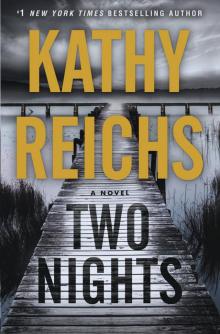 Two Nights
Two Nights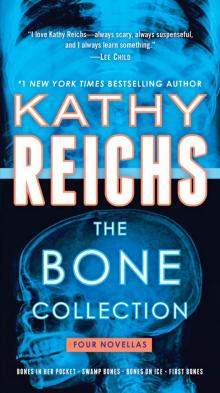 The Bone Collection: Four Novellas
The Bone Collection: Four Novellas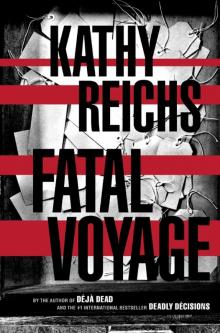 Fatal Voyage
Fatal Voyage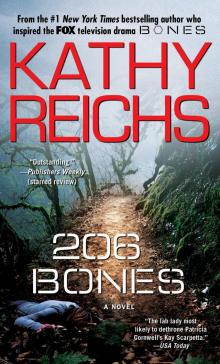 206 Bones
206 Bones Bones to Ashes
Bones to Ashes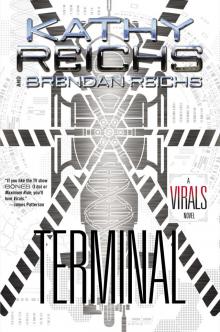 Terminal
Terminal Monday Mourning
Monday Mourning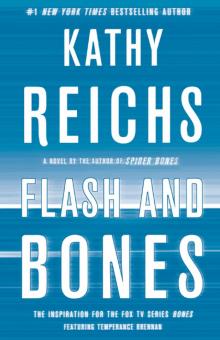 Flash and Bones
Flash and Bones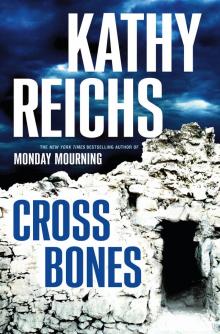 Cross Bones
Cross Bones Devil Bones
Devil Bones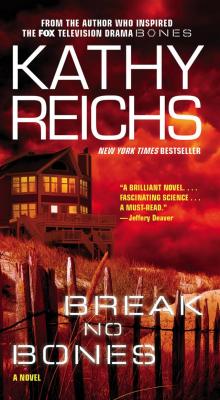 Break No Bones
Break No Bones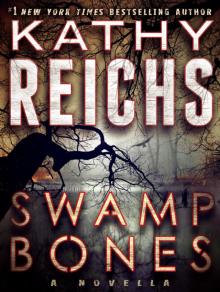 Swamp Bones
Swamp Bones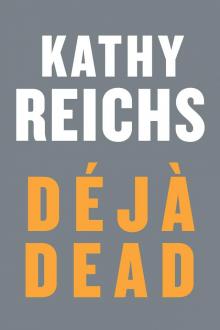 Déjà Dead
Déjà Dead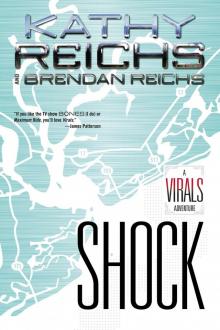 Shock
Shock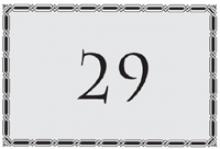 Spider Bones
Spider Bones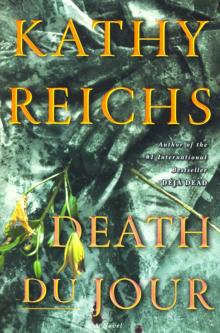 Death Du Jour
Death Du Jour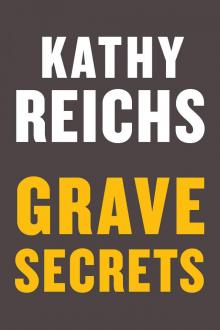 Grave Secrets
Grave Secrets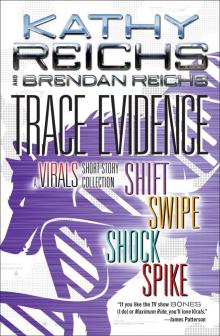 Trace Evidence: A Virals Short Story Collection
Trace Evidence: A Virals Short Story Collection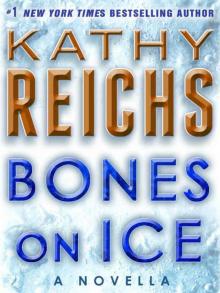 Bones on Ice
Bones on Ice The Bone Code
The Bone Code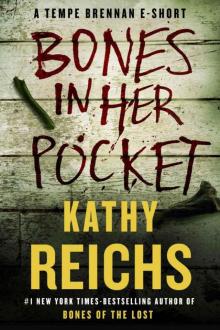 Bones in Her Pocket
Bones in Her Pocket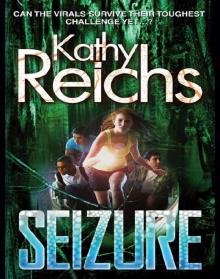 Seizure:
Seizure: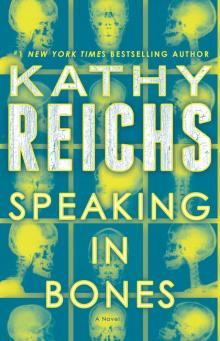 Speaking in Bones
Speaking in Bones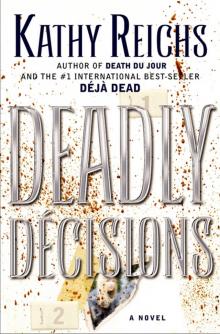 Deadly Decisions
Deadly Decisions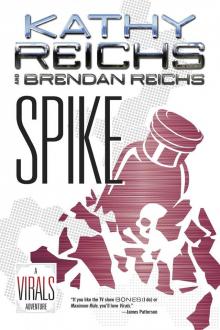 Spike
Spike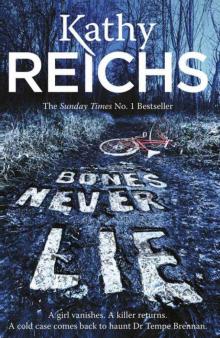 Bones Never Lie
Bones Never Lie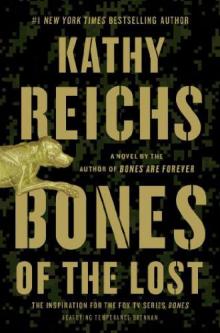 Bones of the Lost
Bones of the Lost Virals 03.5 - Swipe
Virals 03.5 - Swipe Exposure
Exposure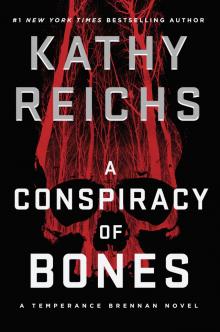 A Conspiracy of Bones
A Conspiracy of Bones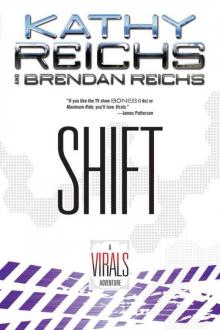 Shift (tory brennan)
Shift (tory brennan)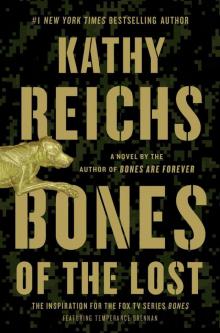 Bones of the Lost: A Temperance Brennan Novel tb-16
Bones of the Lost: A Temperance Brennan Novel tb-16 Virals tb-1
Virals tb-1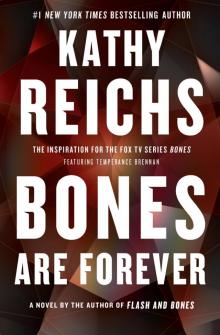 Bones Are Forever tb-15
Bones Are Forever tb-15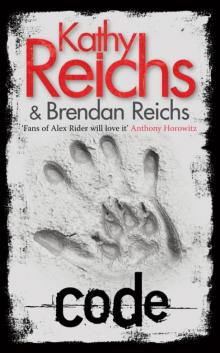 Code tb-3
Code tb-3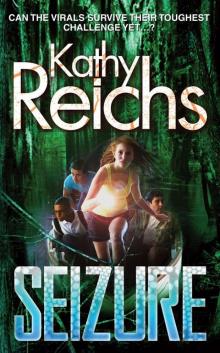 Seizure tb-2
Seizure tb-2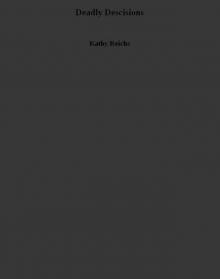 Deadly Descisions
Deadly Descisions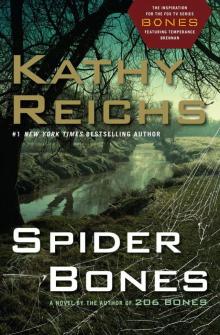 Spider Bones: A Novel
Spider Bones: A Novel